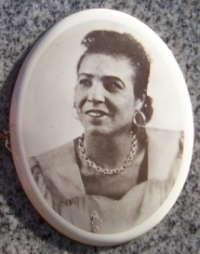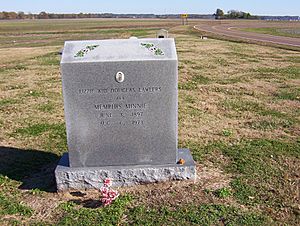Memphis Minnie facts for kids
Quick facts for kids
Memphis Minnie
|
|
|---|---|

Portrait (1940) on Minnie's grave marker
|
|
| Background information | |
| Birth name | Lizzie Douglas |
| Also known as | Kid Douglas, Minnie Lawlars |
| Born | June 3, 1897 Tunica County, Mississippi, U.S. or New Orleans, Louisiana, U.S. |
| Died | August 6, 1973 (aged 76) Memphis, Tennessee, U.S. |
| Genres | Blues, Memphis blues |
| Occupation(s) | Guitarist, vocalist, songwriter |
| Instruments | Guitar, electric guitar, bass, banjo, drums |
| Years active | 1908–1958 |
| Labels | Okeh, Columbia, Vocalion, Decca, Bluebird, Checker, JOB |
| Associated acts | Kansas Joe McCoy, Little Son Joe |
Lizzie Douglas (born June 3, 1897 – died August 6, 1973) was a famous blues musician. She was much better known by her stage name, Memphis Minnie. She was an amazing guitarist, singer, and songwriter. Her music career lasted for over 30 years. She recorded about 200 songs. Some of her most famous songs include "When the Levee Breaks", "Me and My Chauffeur Blues", and "Bumble Bee".
Contents
Early Life and Music
Lizzie Douglas was born on June 3, 1897. She was likely born in Tunica County, Mississippi. However, she sometimes said she was born in New Orleans, Louisiana. She was the oldest of 13 children. Her parents, Abe and Gertrude Douglas, called her "Kid" when she was little. She didn't like the name Lizzie. When she first started performing, she used the name Kid Douglas.
When she was seven, her family moved to Walls, Mississippi. This town is south of Memphis, Tennessee. The next year, she got her first guitar as a Christmas gift. She learned to play the banjo by age 10. By age 11, she was playing the guitar. She started performing at parties around this time. Later, her family moved to Brunswick, Tennessee. After her mother died in 1922, her father moved back to Walls.
Becoming a Star: Her Music Career
In 1910, at just 13 years old, Lizzie ran away from home. She went to live on Beale Street in Memphis. She played music on street corners for many years. Sometimes, she would go back to her family's farm if she needed money. Her street performances led to a tour with the Ringling Brothers Circus. She traveled with them from 1916 to 1920.
In 1929, she began performing with Kansas Joe McCoy. He was her second husband. A talent scout from Columbia Records discovered them. They were playing music for tips outside a barber shop. Minnie and Joe went to New York City to record. Columbia Records gave them the names Kansas Joe and Memphis Minnie. They released many songs together as a duet. In 1930, they recorded "Bumble Bee" for Vocalion. This song became one of Minnie's most popular hits. She recorded five different versions of it! They continued to record for Vocalion until 1934. They divorced in 1935.
The blues musician Big Bill Broonzy once told a story. He said Minnie won a "cutting contest" against him. This was a friendly music battle in a Chicago nightclub in 1933. Each singer performed two songs. Minnie won the prize with her songs "Me and My Chauffeur Blues" and "Looking the World Over".
By 1935, Minnie was living in Chicago. She became a regular musician for record producer Lester Melrose. After her divorce, Minnie started trying out new music styles. She recorded for Bluebird Records and Vocalion. She also toured a lot in the 1930s, especially in the South.
In 1938, Minnie returned to recording for Vocalion. She was joined by Papa Charlie McCoy, Kansas Joe's brother. Around this time, she married guitarist Ernest Lawlars, known as Little Son Joe. They started recording together in 1939. Son added a strong rhythm to Minnie's guitar playing. They recorded for Okeh Records throughout the 1940s. By 1941, Minnie began playing the electric guitar. In May of that year, she recorded her biggest hit, "Me and My Chauffeur Blues". Other popular songs like "Looking the World Over" followed.
In the 1940s, Minnie and Lawlars often played at the 708 Club in Chicago. They were sometimes joined by other famous blues musicians. They also played in other Chicago nightclubs. The famous poet Langston Hughes saw her perform in 1942. He said her voice was "hard and strong" and even stronger with amplification. He described her electric guitar sound as "a musical version of electric welders".
Later in the 1940s, Minnie lived in Indianapolis and Detroit. She returned to Chicago in the early 1950s. By the late 1940s, music tastes were changing. Clubs started hiring younger artists. Record companies like Columbia also began dropping blues artists. Minnie found it hard to adapt. She moved to smaller record labels like Regal and Checker.
Later Years and Legacy
Minnie kept recording into the 1950s. But her health started to get worse. People's interest in her music also faded. She decided to retire from her music career. In 1957, she and Lawlars moved back to Memphis. Sometimes, she would appear on Memphis radio stations. She wanted to encourage young blues musicians. In 1958, she played at a concert to remember Big Bill Broonzy. It is said she never stopped playing her guitar until she physically couldn't anymore.
She had a stroke in 1960. This meant she had to use a wheelchair. Lawlars died the next year. Minnie had another stroke soon after. She struggled financially. Magazines wrote about her situation, and people sent her money to help. She spent her last years in a nursing home in Memphis. She died from a stroke in 1973.
She is buried at the New Hope Baptist Church Cemetery in Walls. A headstone was put up in 1996. The famous singer Bonnie Raitt paid for it. Minnie's sister and 33 other family members were there. The ceremony was even filmed by the BBC. Her headstone reads:
Lizzie "Kid" Douglas Lawlers
aka Memphis Minnie
The back of her gravestone has a special message:
The hundreds of sides Minnie recorded are the perfect material to teach us about the blues. For the blues are at once general, and particular, speaking for millions, but in a highly singular, individual voice. Listening to Minnie's songs we hear her fantasies, her dreams, her desires, but we will hear them as if they were our own.
Personal Life
Minnie was known as a very professional and independent woman. She always took care of herself. She dressed nicely, wearing expensive dresses and jewelry. But she was also strong and stood up for herself. The blues musician Johnny Shines said she wouldn't let anyone bother her. She would use her guitar, a pocket knife, or anything she could find to defend herself. Homesick James said she always chewed tobacco. She even did it while singing or playing guitar. She always had a cup nearby to spit into. Much of her music was about her own life. She put many of her personal experiences into her songs.
Minnie was married three times. Her first husband was likely Casey Bill Weldon in the early 1920s. Her second husband was Kansas Joe McCoy. They married in 1929 and divorced in 1934. Some say Joe was jealous of Minnie's success. Around 1938, she met Ernest Lawlars (Little Son Joe). He became her new music partner. They married soon after. Minnie's records from 1939 onward show her name as Minnie Lawlars. He even wrote songs for her. In one song, he called her "the key to the world."
Minnie was not very religious. She rarely went to church. The only time she was reported to go was to see a gospel group. She was baptized shortly before she died. This was probably to make her sister happy. A house in Memphis where she once lived still exists today.
Her Impact on Music
Memphis Minnie has been called "the most popular female country blues singer of all time." Big Bill Broonzy said she could "pick a guitar and sing as good as any man I've ever heard." Minnie lived to see her music become popular again. This happened during the blues revival in the 1960s. She was added to the Blues Foundation's Blues Hall of Fame in 1980.
Many artists have covered her songs. "Me and My Chauffeur Blues" was recorded by Jefferson Airplane. Donovan recorded "Can I Do It for You" in 1965. A 1929 song by Memphis Minnie and Kansas Joe McCoy, "When the Levee Breaks", was changed and recorded by Led Zeppelin in 1971. "I'm Sailin'" was covered by Mazzy Star.
Her family is currently working to get royalties. They are suing record companies and some artists. They want payment for using her music without permission. In 2007, Minnie was honored with a marker. It is on the Mississippi Blues Trail in Walls, Mississippi.
Songs
Discography
Compilations
| Year | Title | Genre | Label |
|---|---|---|---|
| 1964 | Blues Classics by Memphis Minnie | blues | Blues Classics |
| c. 1967 | Early Recordings with Kansas Joe McCoy, vol. 2 | blues | Blues Classics |
| 1968 | Love Changin' Blues: 1949, Blind Willie McTell and Memphis Minnie | blues | Biograph Records |
| 1973 | 1934–1941 | blues | Flyright Records |
| 1973 | 1941–1949 | blues | Flyright Records |
| 1977 | Hot Stuff: 1936–1949 | blues | Magpie Records |
| 1982 | World of Trouble | blues | Flyright Records |
| 1983 | Moaning the Blues | blues | MCA Records |
| 1984 | In My Girlish Days: 1930–1935 | blues | Travelin' Man |
| 1987 | 1930–1941 | blues | Old Tramp |
| 1988 | I Ain't No Bad Girl | blues | CBS |
| 1991 | Hoodoo Lady (1933–1937) | blues | Columbia |
| 1994 | In My Girlish Days | blues | Blues Encore |
| 1996 | Let's Go to Town | blues | Orbis |
| 1997 | Queen of the Blues | blues | Columbia |
| 1997 | "The Queen of the Blues": 1929–1941 | blues | Frémeaux & Associés |
| 2000 | Pickin' the Blues | blues | Catfish Records |
| 2003 | Me and My Chauffeur Blues | blues | Proper Records Ltd. |
| 2007 | Complete Recorded Works 1935–1941 in Chronological Order, vol. 1, 10 January to 31 October 1935 | blues | Document Records |
| unknown | Night Time Blues, Ma Rainey and Memphis Minnie | blues | History |
Images for kids
See also
 In Spanish: Memphis Minnie para niños
In Spanish: Memphis Minnie para niños




